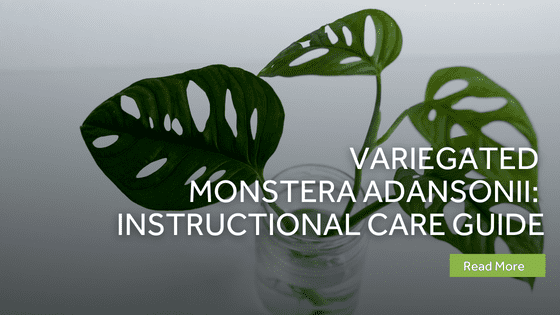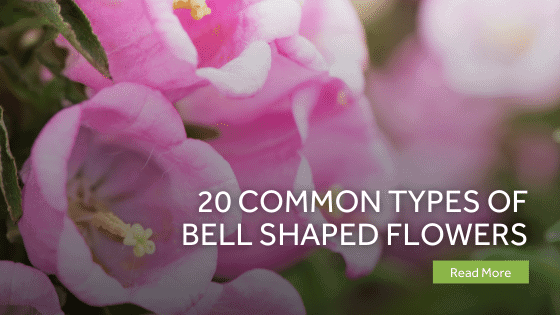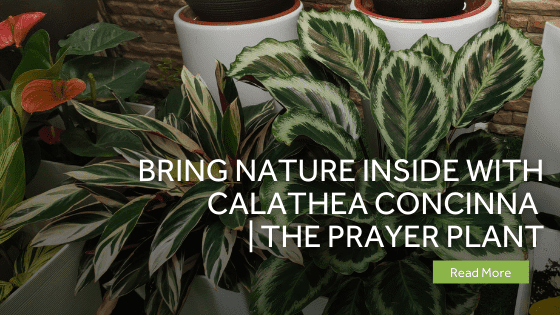The Variegated Monstera adansonii is a rare but popular plant. Its leaves with white spots and holes are telltale signs of this gorgeous plant that requires extensive care because of its lack of chlorophyll.
Knowing how to care for these variegated leaved plants is important if you want to add one to your indoor or outdoor plant collection.
Table of Contents
Variegated Monstera Adansonii Overview
The Variegated Monstera adansonii is of the Araceae family and Monstera plants genus. The genus has 48+ plants, all of which originate from the Amazon rainforests of South America. Most of the plants in this genus have perforated leaves, which is what they are known for.
The Variegated Monstera plants have a variety of names, including the ‘Cheese Plant’ because it is reminiscent of Swiss cheese (also known as the Swiss Cheese plant) and the ‘Window Leaf Plant.’
Each leaf may look different on these variegated Monstera plants, some with green leaves while others have completely white variegation with flowers.
There are several types of Variegated Monstera plants, including:
- Monstera Deliciosa – These leaves are cream and white and larger than the adansonii plant.
- Thai Constellation – These leaves have splotches of white that look like stars.
- Albo Borsigiana – These plants have smaller leaves and grow faster. The color is a darker green too.
- Aurea – These leaves are dark green and yellow on some or all of the leaves.
- Mint Monstera – These leaves have a minty color rather than white spots.
| Botanical Name | Monstera Adansonii |
| Family | Araceae |
| Genus | Monstera |
| Origin | South America |
| Sunlight | A lot of sunlight but not direct sunlight |
| Watering | Every two to three days |
| Soil | Rich and well-draining soil |
| Temperature | 66 – 78 degrees Fahrenheit |
| Propagation | Stem cuttings |
| Re-Potting | Every three years |
| Pests and Diseases | Spider mites, aphids, or mealybugs |
| Toxicity | Toxic to kids and pets |
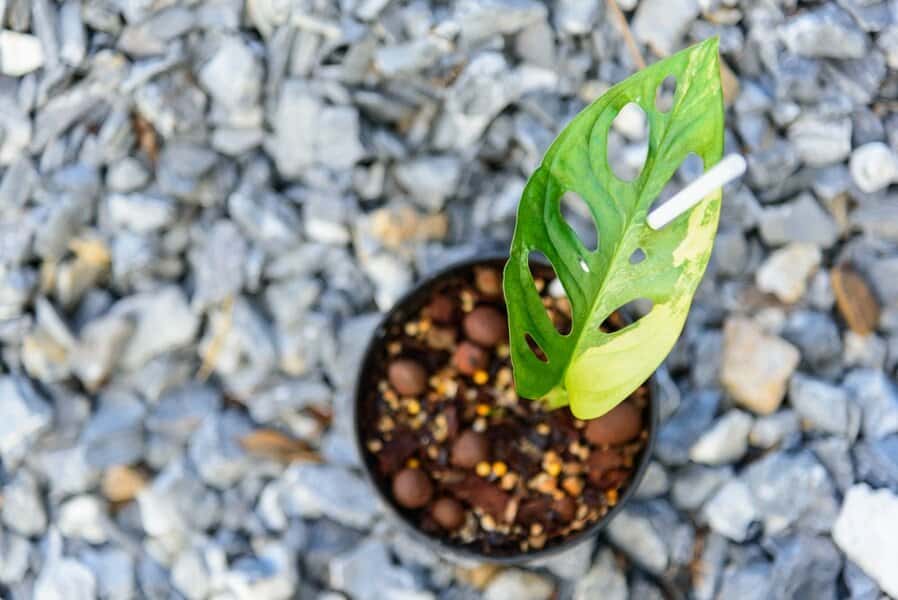
Variegated Monstera Adansonii Features
The Variegated Monstera plants have many different features depending on where they grow (indoors or outdoors) and how they are cared for.
For example, indoor plants get to a height of about 10 feet, whereas those growing in the wild have no limits to how high they can grow. The stems grow upwards when they are young, and once established, they become a vining plant with dangling stems. They take well to different structures, such as hooks or pots, if you want them to grow in a certain direction.
The leaves grow to 2 to 3 feet in size upon full maturity, but in their younger years are about 7 to 10 inches.
Something to be aware of is the toxicity of the Monstera adansonii variegated plant. It has a high level of calcium oxalate crystals which can cause skin allergies upon contact. They can also be irritating if ingested and should be kept away from kids and pets. If you suspect anyone has ingested part of this Swiss Cheese plant, it’s important to seek medical care immediately.
Variegated Monstera Adansonii Care Guide
Caring for the Variegated Monstera adansonii is fortunately very simple. It’s considered a low-maintenance plant, which is great for beginners.
Ideal Growing Place
The Monstera adansonii variegated plant grows well both indoors and outdoors. If you grow it indoors, it will be limited in height, but still grow to be as much as 10 feet tall. They should be kept away from drafts, meaning they shouldn’t be placed in front of open windows or devices that blow air (furnace or A/C).
If you prefer to grow it outdoors, the Monstera Deliciosa does best in zones 9b to 11, which have moderate weather.
Water
The Monstera adansonii variegated plant likes moist soil, but don’t overwater it. In the spring and summer months, you’ll likely water it every two to three days. The key is to water it when the top layer of soil is dry. You want the soil moist, but not too much. If the plant gets direct sunlight or is in a lot of humidity, it may need to be watered more often.
In cooler months, you may only water it once every couple of weeks. If you over water, you prevent oxygen from getting to the roots, which can cause plant diseases like root rot. If you aren’t sure how often to water, stick your finger in the soil, and if the top two inches are dry, it’s time to water.
Sunlight
These variegated plants require a lot of sunlight but not direct sunlight. If you grow it indoors, keep it near a window (not directly in front of it) that’s north or east facing. If you don’t live in a home with a lot of sunlight, you can get an artificial light, leaving the plant under it for at least 10 hours a day. Just like sunlight, though, the light should not be direct.
Temperature
This variegated plant does not do well in extreme temperatures. If you have it outdoors, bring it in before the weather turns as it requires temperatures of 66 – 78 degrees Fahrenheit.
Soil
The Monstera adansonii variegated plant needs soil with a pH level of 5 to 7.5. The soil should be rich and be well-draining soil. To enhance the plant’s drainage, add peat moss or bark to the soil to prevent plant diseases.
You May Also Like: 10 Best Plants Which Are Great For Your Garden
Humidity
Since the Variegated Monsteras are a tropical plant from the rainforests, it’s no surprise they love humidity. They prefer humidity levels of 90% or higher. Because of this need for high humidity, you must provide a humidifier for those colder days.
Other ways to increase the humidity is to use a spray bottle to spray the leaves every couple of weeks. Be careful not to soak the leaves, though, and make sure it’s in a well-ventilated area.
Fertilizer
Fertilizer is a key component of caring for the Monstera adansonii Variegata plant. Because it lacks significant amounts of chlorophyll, the plant needs more nutrients from outside sources. However, you don’t have to buy anything special – a regular plant fertilizer once or twice a month during growing months is good. Since these plants don’t grow in the colder months, they don’t require fertilizer during those times.
Pinching/Pruning
Pruning is a great way to keep your Swiss Cheese plant growing and staying healthy. It’s easy too. Using a sharp pair of scissors, trim away any dead or old leaves. This will help stimulate new growth and help your plant look even stronger.
Potting and Re-potting
It’s best to put your Variegated plant in a pot with drainage holes. These variegated leaved plants usually last in the same pot for three years, depending on how fast they grow. If you notice the roots growing out of the drainage holes, it’s time for repotting. It’s important not to repot in a much larger pot, though. Go up about 2 inches. Too much space for the roots makes them uncomfortable and can cause disease.
Growth Zone
The Variegated Monsteras grow best in zones 9b to 11. They need moderate weather with high levels of humidity.
Common Pests, Toxins, Diseases & Other Problems
The Monstera adansonii variegated plant doesn’t have a lot of trouble with pests, which is nice. However, spider mites, aphids, or mealybugs can take up residence on the back side of the leaves. You’ll be able to tell if the leaves curl toward the back.
Mixing neem oil with water and lightly spraying the leaves will kill the pests without hurting your plant. Do this every couple of weeks until the problem goes away.
Propagation
Growing more Monstera adansonii plants is easy! Using sterilized scissors, and cutting right below the leaf node, cut 4 to 7 inches of stem cuttings. Let the cuttings sit for a few days to prepare them for planting.
Plant the stem cuttings in 3 inches of well-draining soil. Ensure the roots are well within the soil to help them take root and grow. Keep the soil in a warm place, watering when the top 2 inches of the soil become dry. It usually takes 6-8 weeks before you see leaves popping up.
Rhaphidophora Decursiva Mature Timeline
Day 1- 6 weeks: Extract stem cuttings from the mother plant for propagation. Using a spray bottle, keep the top layer of soil moist but not overly saturated. With warmth and indirect, bright light, shoots should begin to develop in 6 weeks.
6 weeks on: With the onset of thriving shoots, follow the typical care protocol described above.
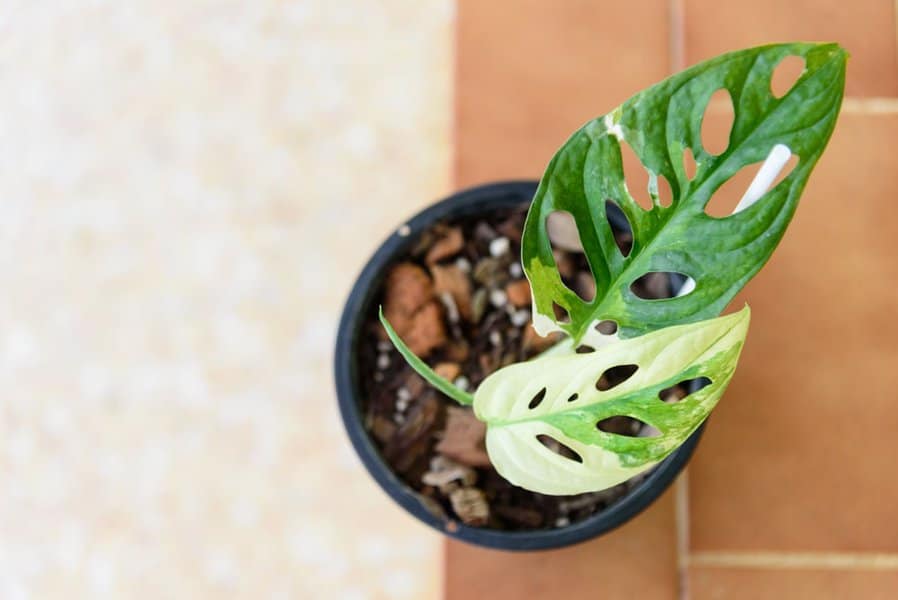
Cheese Plant FAQ
Should I Clean My Monstera Adansonii Variegated?
To keep your Monstera plants healthy, it’s a good idea to periodically wipe the leaves down with a damp cloth. Ensure you dry the leaves off after cleaning them to avoid any diseases.
Is the Monstera Adansonii Variegated Toxic?
The Monstera adansonii variegated plant can be toxic to dogs and cats. While it typically doesn’t cause fatalities, it can cause illness, especially in small dogs, cats, or even children. Keep it out of reach of animals and children and if ingestion is suspected, seek medical attention immediately.
Where Can I Find a Variegated Monstera Adansonii for Sale?
You can buy Variegated Monsteras on Amazon, Etsy, or even at Pottery Barn.
How Much Is the Variegated Monstera Adansonii Price?
Variegated Monstera plants sell anywhere from $50 to $1,000, depending on the variation you purchase.
Why Is Monstera Adansonii Variegated So Expensive?
Because the Monstera plants are slow-growing yet very popular, the price is high. These plants are low in chlorophyll, so they need a lot of extra care and don’t grow as fast as other plants, so the supply is much more limited.
Is the Monstera Adansonii the Same Plant as the Monstera Deliciosa?
Monstera adansonii and Monstera Deliciosa come from the same family, but the plants have many differences. For example, the variegated leaves on the adansonii are much smaller, and the holes on the Deliciosa are much larger. Deliciosa plants also sprawl more than vine. This makes the adansonii plant a better option for hanging plants because the leaves grow down in a vine line way.
Is Variegated Monstera Adansonii Rare?
Yes, the Variegated Monstera adansonii plant is very rare. Because it grows slowly, it’s harder to come by and costs more.
How Fast Does a Monstera Adansonii Variegated Grow?
How fast your adansonii variegated plant grows varies on its growing conditions. On average, though, they grow 1 to 2 feet per year.
How Old Does Variegated Monstera Adansonii Have to Be Before They Bloom?
If you plant stem cuttings, it can take up to 8 weeks for the plant to start showing signs of growth.
The Bottom Line
If you’re looking for a rare plant that grows to 10+ feet, the Variegated Monstera adansonii is a great option. Just make sure you’re aware of its care needs, including its preferred higher levels of humidity, fertilizer needs, and 10+ hours of indirect light requirements.
Because of its popularity, there are many ‘faux’ plants out there. Make sure you buy them from a reputable seller and that you can tell that you are getting the real deal with this plant.
Last Updated on August 26, 2022 by Gustaf Johansson

